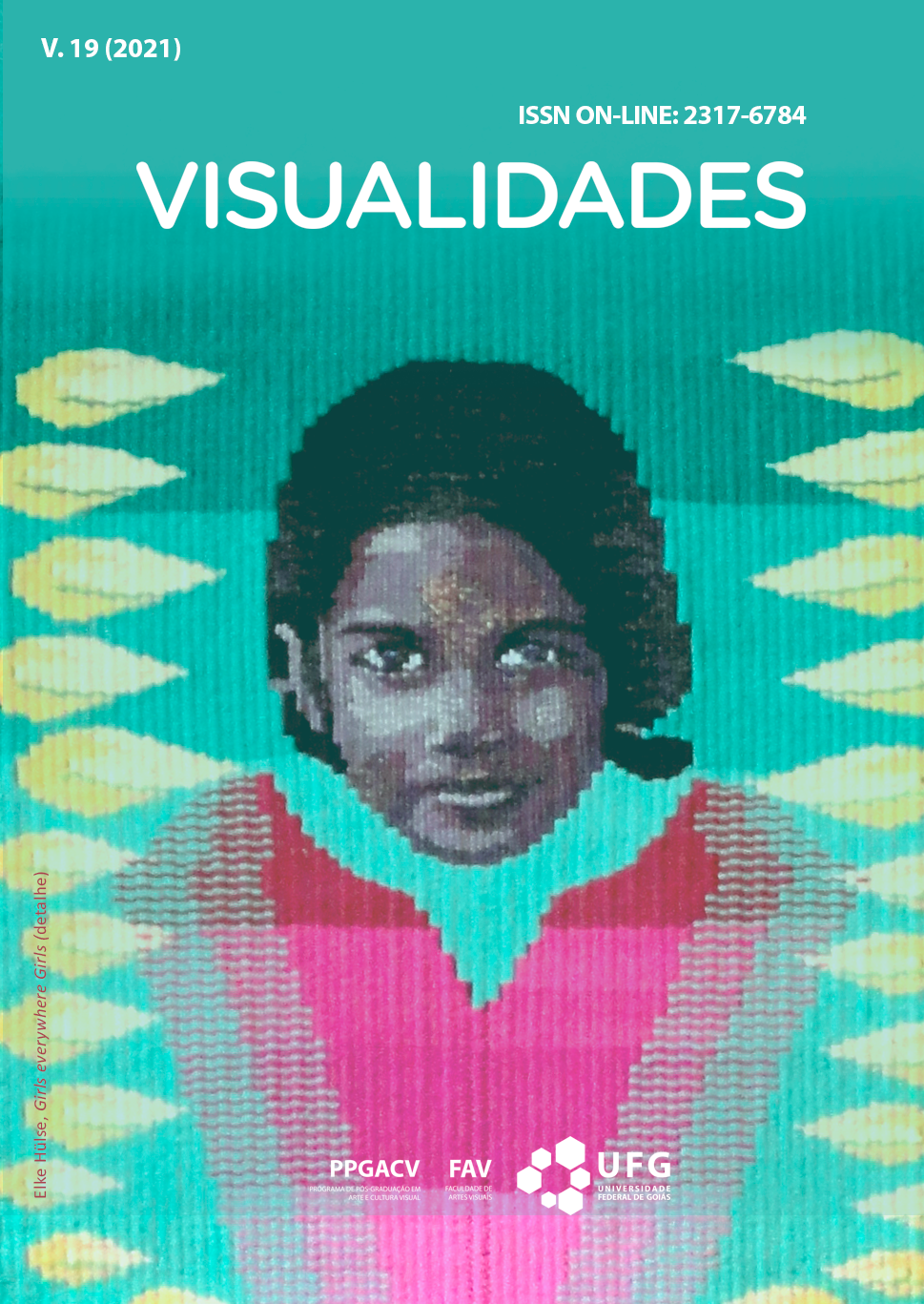This essay analyses the appropriations of African and Afro-Brazilians visual arts works in the teaching of art in basic levels of education in the city of Curitiba, considering the guidelines of the federal law 10.639/2003. It argues about the meanings and discourses given by teachers from the ways of seeing the images. It finds a racialized visuality in pedagogical practices, which could be seen in group interviews using images relevant to the theme. It reveals the permanence of negative stereotypes about the black race and shows an insecurity in teaching and an emergent demand of qualification and research for a teaching practice in favor of this thematic
DOI:
https://doi.org/10.5216/v.v19.60850Keywords:
Law 10.639/2003, Art Education, Racialized VisualitiesAbstract
This essay analyses the appropriations of African and Afro-Brazilians visual arts works in the teaching of art in basic levels of education in the city of Curitiba, considering the guidelines of the federal law 10.639/2003. It argues about the meanings and discourses given by teachers from the ways of seeing the images. It finds a racialized visuality in pedagogical practices, which could be seen in group interviews using images relevant to the theme. It reveals the permanence of negative stereotypes about the black race and shows an insecurity in teaching and an emergent demand of qualification and research for a teaching practice in favor of this thematic.
Downloads
References
BRASIL. Lei de Diretrizes e Bases da Educação Nacional 9.394/96. Estabelece as diretrizes e bases da educação nacional. Diário Oficial [da] República Federativa do Brasil. Brasília, DF, 23 dez. 1996. Disponível em:http://www.planalto.gov.br/ccivil_03/Leis/L9394.htm. Acesso em: 20 jul. 2018.
BRASIL. Presidência da República. Lei 10.639, de 9 de janeiro de 2003. Diário Oficial [da] República Federativa do Brasil. Brasília, DF, 10 jan. 2003. Disponível em: https://www.planalto.gov.br/ccivil_03/leis/2003/l10.639.htm. Acesso em: 20 jul. 2018.
BRASIL. Diretrizes Curriculares Nacionais para a Educação das Relações Étnico-Raciais e para o Ensino de História e Cultura Afro-Brasileira e Africana. Brasília, 2004. Disponível em: http://portal.mec.gov.br/dmdocuments/cnecp_003.pdf. Acesso em: 20 jul. 2018.
GOMES, Nilma Lino. Alguns termos e conceitos presentes no debate sobre relações raciais no Brasil: uma breve discussão. In: BRASIL. Educação antirracista: caminhos abertos pela Lei federal n. 10.639/03. Brasília, MEC, Secretaria de educação continuada e alfabetização e diversidade, 2005. p. 39-62.
GOMES, Nilma Lino. O movimento negro educador: saberes construídos nas lutas por emancipação. Petrópolis: Vozes, 2017.
HERNÁNDEZ, Fernando. Cultura visual, mudança educativa e projeto de trabalho. Porto Alegre: Artes Médicas Sul, 2000.
HERNÁNDEZ, Fernando. ¿De qué hablamos cuando hablamos de cultura visual? Educação & Realidade. Rio Grande do Sul, p. 9-34, jul./dez., 2005.
MARTINS, Raimundo. Das belas artes à cultura visual: enfoques e deslocamentos. In: MARTINS, Raimundo (Org.). Visualidades e Educação. Goiânia, FUNAPE, p. 25-35, 2008.
MARTINS, Raimundo. Por que e como falamos da cultura visual? Visualidades, v. 16, n. 2, p. 64-79, 2018.
MUNANGA, Kabengele. Uma abordagem conceitual das noções de raça, racismo, identidade e etnia. In: SEMINÁRIO NACIONAL RELAÇÕES RACIAIS E EDUCAÇÃO – PENESB. Rio de Janeiro, 2003.
MUNANGA, Kabengele. A dimensão estética na arte negro-africana tradicional. São Paulo: USP/Mac Notícias, 2006.
MUNANGA, Kabengele. Arte afro-brasileira: o que é afinal? In: PEDROSA, A.; CARNEIRO, A.; MESQUITA, A.; MENEZES, H.; SCHWARCZ, L. (Org.). Histórias afro-atlânticas: antologia. São Paulo: MASP, p. 113-124, 2018.
NASCIMENTO, Abdias. Arte afro-brasileira: um espírito libertador. In: PEDROSA, A.; CARNEIRO, A.; MESQUITA, A.; MENEZES, H.; SCHWARCZ, L. (Org.). Histórias afro-atlânticas: antologia. São Paulo: MASP, p. 32-39, 2018.
SILVA, Dilma de Melo. Por que riem da África? São Paulo: NEINB/USP, 2007.
TROVÃO. Fernanda Fares Lippmann. A arte visual africana e afro-brasileira na educação básica: apropriações e significados no ensino de arte. 2019. 194p. Dissertação (Mestrado em Educação) – Universidade Federal do Paraná, Curitiba, 2019.
Downloads
Published
How to Cite
Issue
Section
License
Copyright (c) 2022 Visualidades

This work is licensed under a Creative Commons Attribution 4.0 International License.

This work is licensed under a Creative Commons Attribution 4.0 International License .
Authors who publish in this journal agree to the following terms:
a. Authors retain the copyright and grant the journal the right of first publication, with the work simultaneously licensed under the Creative Commons Attribution 4.0 License which allows the sharing of work with acknowledgment of authorship and initial publication in this journal.
b. Authors are authorized to take additional contracts separately, for non-exclusive distribution of the version of the work published in this journal (eg publish in institutional repository or as a book chapter), with acknowledgment of authorship and initial publication in this journal.
c. Authors are allowed to publish and distribute their work online (eg in institutional repositories or on their personal page) after the initial publication in this journal, as this can generate productive changes, as well as increase the impact and citation of the published work ( See The Effect of Free Access).
Every effort has been made to identify and credit the rights holders of the published images. If you have rights to any of these images and have not been correctly identified, please contact the Visuals magazine and we will publish the correction in one of the next issues.






